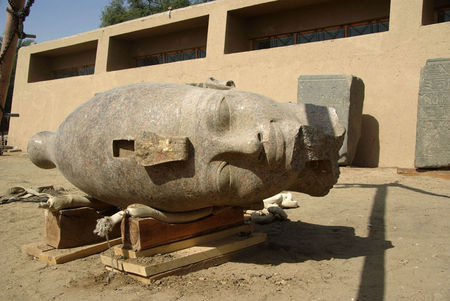Massive Head of Famous Pharaoh Amenhotep III Unearthed in Egypt
The newly unearthed 3,400-year old red granite head, part of a huge statue of the ancient pharaoh Amenhotep III, at the pharaoh's mortuary temple in the city of Luxor. Egypt's Culture Ministry says a team of Egyptian and European archaeologists has unearthed a large head made of red granite of an ancient pharaoh who ruled Egypt some 3,400 years ago. AP Photo/ Supreme Council of Antiquities.
CAIRO (AP).- Archaeologists have unearthed a massive red granite head of one Egypt's most famous pharaohs who ruled nearly 3,400 years ago, the Egyptian Supreme Council of Antiquities announced Sunday.
The head of Amenhotep III, which alone is about the height of a person, was dug out of the ruins of the pharaoh's mortuary temple in the southern city of Luxor.
The leader of the expedition that discovered the head described it as the best preserved sculpture of Amenhotep III's face found to date.
"Other statues have always had something broken: the tip of the nose, the face is eroded," said Dr. Hourig Sourouzian, who has led the led the Egyptian-European expedition at the site since 1999. "But here, from the tip of the crown to the chin, it is so beautifully carved and polished, nothing is broken."
The head is part of a larger statue found several years ago, along with the parts of the body, the back slab, and the ceremonial beard which Souruzian says will soon be connected with the head.
Amenhotep III, who was the grandfather of the famed boy-pharaoh Tutankhamun, ruled from 1387-1348 B.C. at the height of Egypt's New Kingdom and presided over a vast empire stretching from Nubia in the south to Syria in the north.
Sourouzian said the pharaoh was famous for leading Egypt at the peak of its ancient civilization, when peace and luxury were prevalent throughout the kingdom. Craftsmen were also honing their artistic techniques during the period, which may explain the symmetrical features of the unearthed head.
"But he may have looked exactly as this statue and he may have been a very beautiful, very handsome man," Sourouzian told the Associated Press.
Amenhotep III's massive mortuary temple was largely destroyed, possibly by floods, and little remains of its walls.
The expedition, however, has unearthed a wealth of artifacts and statuary in the buried ruins, including two statues of Amenhotep made of black granite found in March. By: Hadeel Al-Shalchi, Associated Press Writer. Copyright 2010 The Associated Press.

/https%3A%2F%2Fprofilepics.canalblog.com%2Fprofilepics%2F1%2F0%2F100183.jpg)
/https%3A%2F%2Fstorage.canalblog.com%2F03%2F02%2F119589%2F96711876_o.jpg)
/https%3A%2F%2Fstorage.canalblog.com%2F11%2F31%2F119589%2F94773502_o.jpg)
/https%3A%2F%2Fstorage.canalblog.com%2F20%2F83%2F119589%2F94772815_o.jpg)
/https%3A%2F%2Fstorage.canalblog.com%2F26%2F72%2F119589%2F75604929_o.jpg)
/https%3A%2F%2Fstorage.canalblog.com%2F59%2F60%2F119589%2F26458628_o.jpg)



/http%3A%2F%2Fstorage.canalblog.com%2F20%2F94%2F119589%2F128675984_o.png)
/http%3A%2F%2Fstorage.canalblog.com%2F78%2F84%2F119589%2F126266259_o.jpg)
/http%3A%2F%2Fstorage.canalblog.com%2F61%2F48%2F119589%2F126266099_o.jpg)
/http%3A%2F%2Fstorage.canalblog.com%2F22%2F18%2F119589%2F122439819_o.jpg)